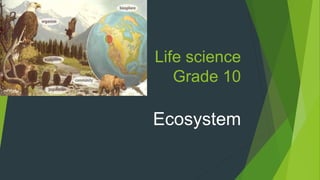Lifescienceecosystem 140411110511-phpapp02
- 2. Learning outcomes ’üĄ At the end of this chapter learners should be able to: ’üĄ Define ecosystem and other important terms ’üĄ Draw and label a food web ’üĄ Discuss the food pyramids and energy pyramids in details ’üĄ Discuss biomass in details ’üĄ Explain the energy transfer in the ecosystem.
- 3. ECOSYSTEMS An ECOSYSTEM is all the different organisms in the world living together in a PARTICULAR ENVIRONMENT or HABITAT Our own bodies are homes to tiny living organisms! All the ecosystems combined together make up the BIOSPHERE
- 4. An ecosystem is an environment in which plants (flora) and animals (fauna) live. Ecosystems survive through the interactions between plants and animals and an example of this is what are referred to as food chains and food webs. Without these interactions, ecosystems risk breaking down and could be destroyed - we will look at this in more detail when we look at ecosystems under threat.
- 5. Ecosystem ’üĄ The collection of organisms in an area along with the important environmental factors ’üĄ Eg ocean ecosystem
- 7. Population ’üĄ A population is the number of organisms of the same species living in a habitat
- 8. Community All the animals and plants living in an ecosystem
- 9. Habitat ’üĄ The area where animals and plants live ’üĄ Eg ocean habitat ’üĄ Or.. More specific Coral habitat
- 10. Trophic levels The level occupied by a consumer in a food chain is referred to as a feeding or TROPHIC level. Primary consumers occupy the 1st trophic level; secondary consumers occupy the 2nd trophic level, and so on.
- 11. Food Chain ’üĄ A food chain is a linear sequence of links in a food web starting from a species that are called producers in the web and ends at a species that is called decomposers species in the web. A food chain also shows how the organisms are related with each other by the food they eat. A food chain differs from a food web, because the complex polyphagous network of feeding relations are aggregated into trophic species and the chain only follows linear monophagous pathways. A common metric used to quantify food web trophic structure is food chain length. In its simplest form, the length of a chain is the number of links between a trophic consumer and the base of the web and the mean chain length of an entire web is the arithmetic average of the lengths of all chains in a food web
- 12. Producer Primary Consumer Herbivore Secondary Consumer Carnivore Tertiary Consumer Carnivore
- 13. What happens if a link in the food chain is broken? X X
- 14. Food webs The interrelationship between many food chains is called a food web.
- 15. Biomass Biomass is an estimate of the amount of matter in a given population of organisms. Biomass for different trophic levels is compared in a biomass pyramid. A biomass pyramid shows how the quantity of matter in living things changes along a food chain.
- 16. Pyramid of Biomass The base of the pyramid represents the matter in producers. The next level shows biomass of primary consumers and so onŌĆ”.
- 17. Biomass decreases as you go up the pyramid An energy pyramid shows the total energy in trophic levels and how that energy is lost along a food chain.
- 19. Energy pyramid
- 20. Decomposers Organisms that use the organic matter of dead plants and animals are called decomposers. They release digestive enzymes to break down organic matter and then absorb the products of digestion. Decomposers include fungi and bacteria. Decomposers do not fit readily into one trophic level.
- 21. So where does all the energy go if not 100% from one organism to the next???
- 22. Energy losses in food chains 1. Some parts of the organism not eaten 2. Some parts are not eaten but cannot be digested and are therefore lost in feaces 3. Some of the energy is lost in excretory materials, such as urine 4. Some energy losses occur as heat from respiration and directly from the body to the environment. Why would energy losses be higher in birds and mammals compared to reptiles/amphibians?
- 23. Energy transfer in ecosystems
- 24. Stoat Toad Caterpillar Grass 1. Limits to 4/5 organisms because insufficient energy is available to support a large enough breeding population at trophic levels higher than these 2. Total mass of organisms in a particular place (biomass) is less at higher trophic levels 3. Total amount of energy stored is less at each level as one moves op a food chain How does the relative inefficiency of energy transfer between trophic levels affect food chains? Trophic level

























